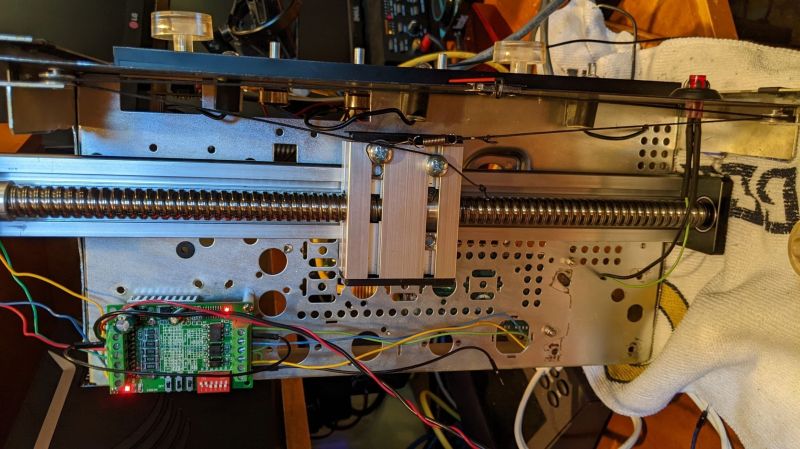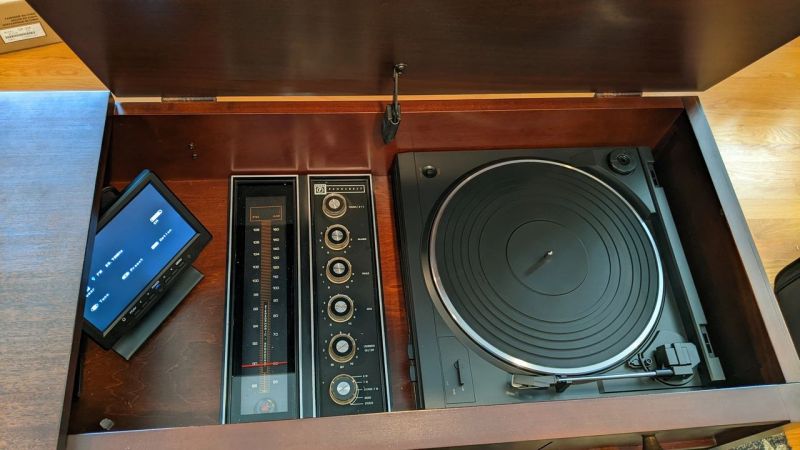Faced with an old console stereo from the 1960s that was barely functional, [Sherman Banks] aka W4ATL decided to upgrade its guts while keeping its appearance as close to the original as possible. This stereo set is a piece of mahogany furniture containing an AM/FM stereo receiver and an automatic turntable from JCPenny’s Penncrest line. As best [Sherman] can determine, it is most likely a 1965 model. The old electronics were getting more and more difficult to repair and the tuner was drifting off-station every 15 minutes. He didn’t want to throw it away, so he decided to replace all the innards.
The first thing was to tear out the old electronics while retaining the chassis proper. The new heart of the entertainment center is a modern Denon AV stereo receiver. This unit can be controlled over Ethernet, has a radio tuner, inputs for SiriusXM and a turntable, and supports Bluetooth streaming. [Sherman] next replaced the 1965 turntable, and then turned his attention to connecting up the controls and indicators.

The potentiometers were replaced with equivalent ones of lower resistance, the neon stereo indicator was replaced with an LED, but the linear tuning dial proved to be a nearly two month challenge and resulted in a cool hack. In brief, he connected an optical rotary encoder to the tuning knob and used a stepper motor with a linear actuator to control the dial indicator. All this is controlled from an Arduino Mega 2560 with three shields for I/O and LAN. But there was still one remaining issue — without vacuum tubes to warm up, the radio would play immediately after power-on. [Sherman] fixed that by programming the Arduino to slowly ramp up the volume at the same rate as the original tube receiver. And finally, he installs a small HDMI monitor in the corner to display auxiliary information and metadata from the Denon receiver.
Check out the videos below the break. We wrote about a couple of similar conversions in the past: this one from 2018 was also a Penncrest, and from last year this COVID isolation project that emphasized the addition of a new liquor cabinet.

















What about speakers? I am guessing that the original speakers were probably higher quality than new speakers.
The original speakers were replaced with the Dayton BR-1 kit. The new speakers were close to the same size as the old speakers and included parts for the crossover network.
I have a 1955 untouched for sale u know any one want to buy its for the low 200.00 email me donniejones290@gmail.com
Highly unlikely. Speaker design, materials, and manufacturing technology has advanced significantly since then. Those would have been simple paper cones with weak AlNiCo drivers, and I’m not even sure what the surround or spider would have been made from. I doubt they even managed to control for basket resonance.
You might be surprised actually. A lot of specs are no longer as important, primarily sensitivity. It has become drastically cheaper to produce higher power amplifiers, so now speakers are often less efficient. I have been through a lot of speakers as a sound engineer, and its often hard to find good drivers these days unless you are buying pro-audio speakers and diligently doing the math.
Seems like a huge stepper motor for moving the dial, and makes a lot of noise. But I always like seeing old stuff repurposed to modern, but still looks old. Fun project.
This is so overkill, i love it! Although humble, I never liked repairing the ‘wire-controled’ tuning caps on ‘old’ radio sets.
This ballscrew and stepper will lift dial, you, and your spirit – all in same time if necessary.
I liked old receivers that used a flywheel knob for the tuning. You could give it a good spin to go to the other end of the dial. Usually tuning knobs vary a capacitor. Surely there’s a way to A-to-D that?
I agree. Using the original dial mechanism, string/pulley/variable capacitor … one could use the physical position of the capacitor to know where the dial is located. It’s the feel of that dial (with the mechanism) that needs to be retained.
I fully agree that keeping the tuning mechanism intact is beneficial. I’ve had great results with using the tuning capacitor as the C of an RC or LC oscillator, squaring up the output, and measuring the frequency with an MCU. I’ve also had decent results replacing the tuning capacitor with a ww 3 turn pot (they typically require very light effort to rotate the shaft) connected as a voltage divider.
It is likely a Superheterodyne receiver. You don’t need to build an oscillator. Just measure the existing Local Oscillator frequency and offset that by the IF frequency (AM:455kHz or FM:10.7MHz)
https://en.wikipedia.org/wiki/Superheterodyne_receiver
The flywheel needs to be on the rotary encoder with 10 or more increments per 200kHz channel, then you would get the feel of “fine tuning” and be able to spin fast too.
Magnavox and Capehart were made in Indiana with native hardwoods. The cabinet was what mattered most to these buyers and aren’t being made anywhere anymore.
I asked Sherman about the apparent jerkiness of the tuning indicator. That’s not a result of the rotary dial / linear actuator setup, but because the Denon receiver only allows you to tune on the assigned, discrete channels for FM radio stations (I didn’t ask about AM stations, hmmmm). You’ll notice when it changes / searches for the next station, the dial does move smoothly. In the US and some other countries, stations are only allocated on odd multiples of 100 KHz. But interestingly, according to Wikipedia, some countries allow all 100 kHz multiples, and Italy uses 50 kHz. Maybe there’s someway to trick the Denon into thinking it is in Italy?
So the AM band seems to allocate stations on 10 kHz multiples. Over the range 540 to 1700 kHz, that’s 116 steps (assuming Denon’s AM receiver digital tuning commands work like their FM tuner does). For the FM band in the 87.5 to 108.0 MHz range, assuming odd multiples of 100 kHz that gives 102 channels (or 204 in the UK where all 100 kHz intervals are used, or 408 channels in Italy with 50 kHz spacing). How many discrete steps in a, say, 12-inch tuning dial would give the appearance of smooth continuous motion?
Nice work, should serve him for years more.
Id be interested in finding out what turntables one could drop into a console like that. I have an old one from my parents I wouldnt mind doing that to.
Too bad he couldn’t have salvaged and used the original turntable. I didn’t watch the whole video, but having the dial scroll to presets would be a nice touch if it wasn’t done or shown.
Wow. I’ve got an old console radio / record player that looks almost exactly like that which I inherited from my parents. I’m surprised I didn’t destroy it as a kid… I remember playing records on it when I was like 4 years old.
I can’t believe he went to all that trouble and installed a low quality turntable! Other than that it’s cool!
Mr. Lott.
We recently purchased a similar unit and wish to update it. I’ve tried an internet search in my area and am not getting results for this type of work. Do you have any recommendations on how to seek out reputable technicians? Thank you. I love what you did with the beautiful console unit.